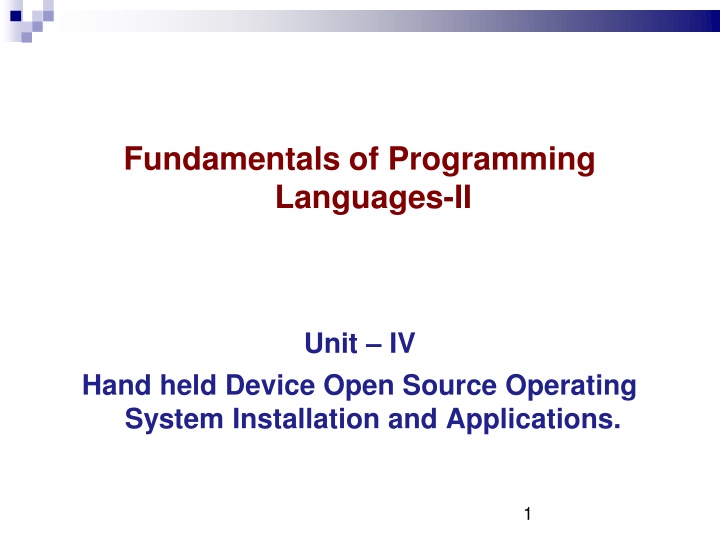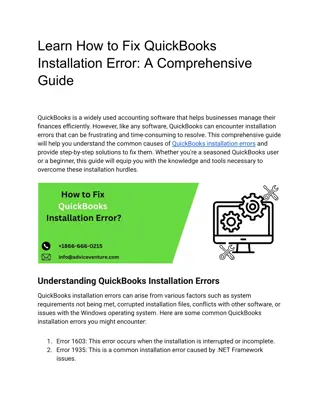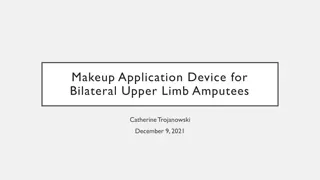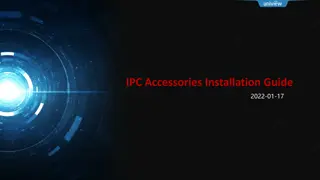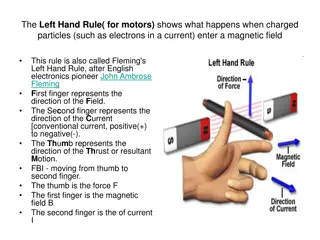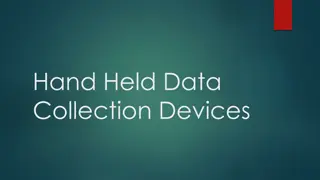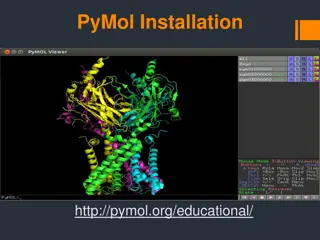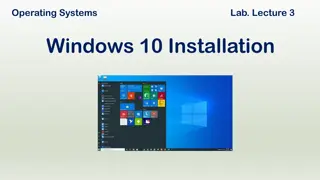Hand-held Device Open Source OS Installation & Applications
Hand-held devices such as mobile phones, smartphones, and tablet computers run on mobile operating systems. Android is a widely used mobile OS developed by Google and the Open Handset Alliance. The history of Android development includes various versions with unique features. Android OS is open-source, runs on different cellular standards, supports third-party applications, multitasking, multiple languages, and offers an attractive user interface. Comparisons with other OS like iOS, BlackBerry, and Symbian highlight differences in CPU architecture, programming languages, and licensing. The Android architecture consists of four layers, each serving specific components for application development.
Download Presentation

Please find below an Image/Link to download the presentation.
The content on the website is provided AS IS for your information and personal use only. It may not be sold, licensed, or shared on other websites without obtaining consent from the author.If you encounter any issues during the download, it is possible that the publisher has removed the file from their server.
You are allowed to download the files provided on this website for personal or commercial use, subject to the condition that they are used lawfully. All files are the property of their respective owners.
The content on the website is provided AS IS for your information and personal use only. It may not be sold, licensed, or shared on other websites without obtaining consent from the author.
E N D
Presentation Transcript
Fundamentals of Programming Languages-II Unit IV Hand held Device Open Source Operating System Installation and Applications. 1
Overview of Andriod OS What is Mobile OS? OS specially designed to run on mobile devices (mobile phones, smart phones, PDA, Tablet Computers and other hand held devices . Other programs run on top of this OS on mobile device. Android is most widely used mobile OS It is a Software stack for mobile devices that include an operating system based on LINUX, middleware user application that can be downloaded. It was developed by Google and Open Handset Alliance(OHA) Android Open Source Project (AOSP) is assigned with maintenance & further development of Android 2
History of Andriod Development Android Version Releasing Year Main Feature A 1.1 Feb 2009 Provide support for saving attachments for MMS. A 1.5 April 2009 Uploading videos on YouTube and Picasa Multi-lingual speech synthesis, gesture builder development tool A 1.6 Sept. 2009 A 2.0 / 2.1 Oct. 2009 HTML 5 file support, Bluetooth 2.1 A 2.2 May 2010 Adobe Flash 10.1 support A 2.3 Dec. 2010 Multi touch software key board A 3.0 May 2011 3D Desktop, GTalk and video chat support Attractive UI, adjustable widgets, voice i/p engine, richer camera facilities, more powerful web browsing. A 4.0 Ice Sandwhich Oct. 2011 A 4.1.x (Jelly Bean) Improved & smoother UI, improved voice search, Multi channel & USB audio, resizable widgets 2012 3
Overview of Android OS Features of ANDROID Open Source Runs on almost all deployed cellular standards like GSM, CDMA Allows third parties to develop applications for Android phones. Multitasking. More secure. Provides support for multiple languages. Improved performance. Attractive and flexible UI Offers own cloud. 4
Comparison of Android with other OS Mobile OS IOS Android Black Berry Symbian OHA and Google Symbian Foundation Company Apple RIM Latest Version 6.0 4.4 Kitkat 7.1 Nokia Belle CPU Architecture ARM, Power MIPS, x86 ARM ARM ARM Programming Language used to write OS C, C++, Objective C C, C++, Java Java C++ Eclipse Public License Licensing Proprietary Open Source Proprietary In Jell Bean & onwards Multi User NO NO NO 5
Android Architecture Android has four layered architecture Application Layer. Application Framework Layer. Native Libraries, Daemons & services (written in C / C++) Linux Kernel. Applications Each layer is a group of several components. Application Framework Software Stack of different layers Android runtime It includes OS, middleware & imp. applications Libraries Linux Kernel 6
Android Architecture Application Layer: Responsible for holding user applications. Standard applications (Home, Contacts, browser etc.) are pre-installed in devices. Developers can replace existing system application by writing new one. Application Framework Supports development of applications. Encompasses Android Managers & providers that abstract supporting H/W, device resources and services. Offers basic tools for application development. Contains : Activity Manager, Telephony Manager, Location Manager, Resource Manager. Content Manager, 7
Android Architecture Application Framework Activity Manager : Manages Activity life cycle of application. Content Manager : Manages Data sharing between applications. Telephony Manager : Manages voice calls. Location Manager : Location management using GPS or cell tower. Resource Manager : Manages various resources that we use in our applications. 8
Android Architecture Libraries Handles different types of Data. Written in C or C++ language, specific for particular H/W. Native Libraries include SQLite : is database engine used in Android for data storage. WebKit : browser engine used to display HTML content. Surface Manager : Compositing window manager with off- screen buffering, due to which transparency in windows. Media Framework : Provide different media codec for recording & playing different media formats Open GL: Render 2D or 3D graphics content on screen.9
Android Architecture Android RunTime: Contains Dalvik Virtual Machine and Core Java Libraries. Java Source Code Java byte Code Dalvik byte Code Dalvik executable Developed by Dan Bornstein of Google. Used to run apps and optimized for low processing and low memory environment. DVM runs .dex files, are built from .class file at compilation time & provide higher efficiency in low resource environments. DVM allows multiple instance of VM, providing security, isolation, memory mngt. and threading10
Android Architecture Linux Kernel: It takes core system operations process management, power management, memory management, device driver control and network programming. Android OS is built on Linux 2.6 kernel, with some changes made by google. Linux kernel act as abstract between H/W and other S/W layer. Layer includes Drivers for Display, Keypad, Camera, Wi Fi, Flash memory, Audio, Binder, Power mangement routines 11
Wireless Application Protocol Show the internet contents on wireless clients like mobile phones, PDAs etc. WAP browsers run within the memory and bandwidth constraints of phone. WAP serves pages written in markup language called Wireless Markup Language. Pages are displayed on WAP browser, but pages are simpler in design. Wireless Application Protocol (WAP) is standard for accessing information over mobile wireless network. 12
WAP Protocol (stack) WAP designed for micro browser. HTML Java Script HTTP protocol in the client-server computing model. functions as a request-response HTTP are designed to provide communication security over the Internet cryptographic protocols which are TLS - SSL TCP/IP provides end-to-end connectivity specifying how data should be formatted, addressed, transmitted, routed and received at the destination. UDP connection less services. TCP/IP UDP/IP 13
WAP Architecture Application Layer (Wireless Application Environment / WAE) Other Services and Applications Session Layer (Wireless Session Protocol / WSP) Transaction Layer (Wireless Transaction Protocol / WTP) Security Layer (Wireless Transport Layer Security/WTLS) Transport Layer (WDP) Datagram Wireless Bearers GSM, CDMA, PHS, CDPD, PDC-P etc. 14
Multiple Choice Questions Andriod is based on _________ operating system. a) Linux b) Windows c) Mac d) Sun Solaris OHA stands for _______________. a) Open Hardware Alliance b) Open Handset Alliance c) Open Handset Application d) Oracle Handheld Alliance Andriod application framework accesses the libraries through_____ a) JVM b) DVM c) CVM d) JIT 15
Multiple Choice Questions IOS is properietry. a) True b) False Dalvik VM is register based. a) True b) False Symbian OS is programmed in ____. a) Java b) Python c) C++ d) VB Android is owned by______. a) Apple b) RIM c) Google d) Microsoft 16
Multiple Choice Questions Objective C is used in development of ios. a) True b) False Dalvik compiler converts .java files to .class files. a) True b) False Android uses _____ as database. a) Oracle b) MS Access c) MS SQL d) SQLite Device driver communicates with the ____. a) Application b) Hardware c) software d) None of these. 17
Multiple Choice Questions ________ is assigned with task of maintenance and further development of Android. a) Google b) OHA c) AOSP d) PaloAlto Andriod Runtime is part of _____. a) Application Framework b) Applications c) Libraries d) Linux Kernel Data Sharing between applications is managed by _____________. a) Activity Manager c) Telephony Manager b) Content Manager d) Location Manager. 18
Multiple Choice Questions ____ acts as abstract layer between H/W and other S/W layers. a) Application b) Application Framework c) Linux Kernel d) DVM WebKit is ___________. a) Database engine b) Browser Engine c) Search Engine d) None of these. Content Provider manages the activity life cycle of application. a) True b) False 19
Multiple Choice Questions Black Berry supports ARM CPU architecture type. a) True b) False ios supports x86 architecture type. a) True b) False ________ is responsible for java byte code to dalvik byte code conversion. a) Java Compiler c) Dalvik compiler b) Gcc compiler d) None of these. DVM is developed by _____. a) Linus Torvald c) Dan Bornstein b) Dennis Ritchie d) Dalvik Bornstein 20
Multiple Choice Questions WAP is designed to work for micro browsers on mobiles. a) True b) False WAP enables the application development for handheld portable devices.. a) True b) False WAP is a technical standard for accessing information over a __________. a) Mobile wireless network b) Wired Network c) Bluetooth d) Infrared. 21
Multiple Choice Questions GSM is one of the wireless bearers in WAP architecture. a) True b) False ADT is ___________ for Eclipse IDE. a) Protocol c) Plug-in b) Library function d) None of these. Android runs on _____ deployed cellular standards. a) GSM c) Neither A nor B b) CDMA d) Both A and B. Jelly Bean is not popular name for Android version. a) 4.1 c) 4.3 b) 4.2 d) 4.4 22
